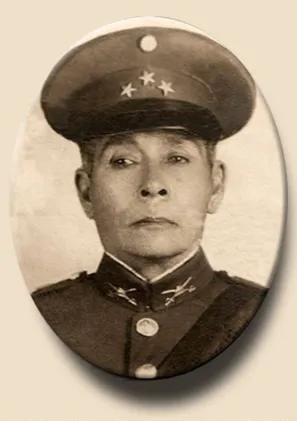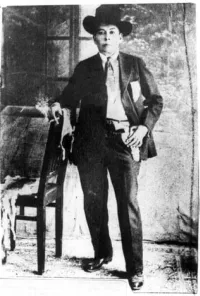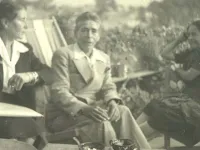Biography
1889 - 1984
Born in 1889 in Xochipala, Guerrero to a moneyed family, Amelio Robles Avila was educated as a strict Catholic. Assigned female at birth, Avila became part of the Society of the Daughters of Mary of the Miraculous Medal. At an early age, Amelio began to show a liking for skills that were traditionally associated with men such as the handling of weapons, shooting, roping, and mounting and taming horses. In 1912, he joined the Mexican Revolution when General Juan Andrew Almazan passed through his hometown. He was first sent on a mission to the Gulf of Mexico as part of a committee to raise funds from oil companies to aid the revolutionary cause. From 1913-1918 he fought under the command of the main revolutionary leaders of the state – Jesus H. Salgado, Heliodoro Castillo, and Diaz Encarnacion. In the process, Avila adopted the male attire of a proud guerrillero and became Zapatista Colonel Amelio Robles Avila – a key leader in the Mexican Revolution. Participating in many battles, Avila was known to shoot his pistol with his right hand while holding his cigar in the left. Avila openly displayed his attraction to women and when he met Angela Torres while in Apipilulco; she became his companion for most of the next decade. The military accepted Robles claims to a masculine identity and granted him a veteran’s pension. In 1970, he was officially recognized as a Veteran of the Mexican Revolution and awarded a medal as Honorary Legionnaire of the Mexican Army. In 1973, he received the Merit revolutionary. He died in December of 1984 at the age of 95.
1889 - 1984
Born in 1889 in Xochipala, Guerrero to a moneyed family, Amelio Robles Avila was educated as a strict Catholic. Assigned female at birth, Avila became part of the Society of the Daughters of Mary of the Miraculous Medal. At an early age, Amelio began to show a liking for skills that were traditionally associated with men such as the handling of weapons, shooting, roping, and mounting and taming horses. In 1912, he joined the Mexican Revolution when General Juan Andrew Almazan passed through his hometown. He was first sent on a mission to the Gulf of Mexico as part of a committee to raise funds from oil companies to aid the revolutionary cause. From 1913-1918 he fought under the command of the main revolutionary leaders of the state – Jesus H. Salgado, Heliodoro Castillo, and Diaz Encarnacion. In the process, Avila adopted the male attire of a proud guerrillero and became Zapatista Colonel Amelio Robles Avila – a key leader in the Mexican Revolution. Participating in many battles, Avila was known to shoot his pistol with his right hand while holding his cigar in the left. Avila openly displayed his attraction to women and when he met Angela Torres while in Apipilulco; she became his companion for most of the next decade. The military accepted Robles claims to a masculine identity and granted him a veteran’s pension. In 1970, he was officially recognized as a Veteran of the Mexican Revolution and awarded a medal as Honorary Legionnaire of the Mexican Army. In 1973, he received the Merit revolutionary. He died in December of 1984 at the age of 95.
Demography
Demography
Gender Male
Sexual Orientation Straight
Gender Identity Transgender
Ethnicity Black Latinx
Faith Construct Catholic
Nations Affiliated Mexico
Era/Epoch Mexican Revolution (1910-1946)
Field(s) of Contribution
Military
Commemorations & Honors
Decoration as a Veteran of the Mexican Revolution
Honorary Legionnaire of the Mexican Army
Revolutionary Merit Award Recipient
Mexican Secretary of National Defense Recognized Robles as a Veteran of the Revolution (1970)
Received Title of Mérito Revolutionario (1973)
Demography
Gender Male
Sexual Orientation Straight
Gender Identity Transgender
Ethnicity Black Latinx
Faith Construct Catholic
Nations Affiliated Mexico
Era/Epoch Mexican Revolution (1910-1946)
Field(s) of Contribution
Military
Commemorations & Honors
Decoration as a Veteran of the Mexican Revolution
Honorary Legionnaire of the Mexican Army
Revolutionary Merit Award Recipient
Mexican Secretary of National Defense Recognized Robles as a Veteran of the Revolution (1970)
Received Title of Mérito Revolutionario (1973)
Resources
Resources
http://culturacolectiva.com/amelia-robles-avila-el-coronel-de-la-revolucion/
http://muse.jhu.edu/journals/the_americas/summary/v064/64.3wood.html
http://www.bibliotecas.tv/zapata/zapatistas/amelia_robles.html
https://www.intomore.com/culture/amelio-robles-avila-trans-legend-of-the-mexican-revolution
Resources
http://culturacolectiva.com/amelia-robles-avila-el-coronel-de-la-revolucion/
http://muse.jhu.edu/journals/the_americas/summary/v064/64.3wood.html
http://www.bibliotecas.tv/zapata/zapatistas/amelia_robles.html
https://www.intomore.com/culture/amelio-robles-avila-trans-legend-of-the-mexican-revolution




